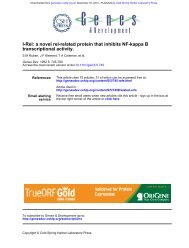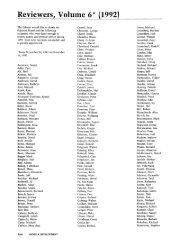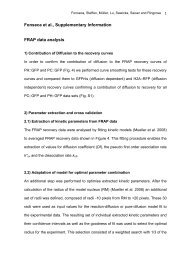Pancreatic cancers require autophagy for tumor growth - Genes ...
Pancreatic cancers require autophagy for tumor growth - Genes ...
Pancreatic cancers require autophagy for tumor growth - Genes ...
You also want an ePaper? Increase the reach of your titles
YUMPU automatically turns print PDFs into web optimized ePapers that Google loves.
et al. 2010). To date, the most effective strategy of combining<br />
inhibition of the Hedgehog pathway with gemcitabine<br />
increased median survival by 14 d (Olive et al.<br />
2009) and is the basis <strong>for</strong> several human clinical trials<br />
currently under development. Our studies employed a similar<br />
Kras-driven genetically engineered mouse model<br />
(GEMM) of PDAC (Hingorani et al. 2003; Bardeesy et al.<br />
2006). Mice were treated with CQ following the establishment<br />
of advanced PanINs or focal PDAC and monitored<br />
<strong>for</strong> PDAC progression. As observed in the xenograft<br />
and orthotopic models, CQ treatment led to a significant<br />
increase in survival in the Kras-driven PDAC GEMM,<br />
leading to a robust 27-d increase in median survival as a<br />
monotherapy (Fig. 8H).<br />
Discussion<br />
Downloaded from<br />
genesdev.cshlp.org on June 4, 2013 - Published by Cold Spring Harbor Laboratory Press<br />
Figure 5. Autophagy is regulated by ROS<br />
in PDAC. (A) Theleft panel shows 8988T<br />
cells treated with CQ (25 mM) to inhibit<br />
<strong>autophagy</strong> and stained with DCF-DA<br />
to determine ROS levels by measuring<br />
fluorescence by FACS. Note the greater<br />
ROS levels, indicated by the increased<br />
fluorescence upon CQ treatment (blue<br />
curve). The right panel shows a similar<br />
increase in ROS when <strong>autophagy</strong> is inhibitedbysiRNAtoATG5.(B)<br />
Inhibition<br />
of <strong>autophagy</strong> by treatment with CQ increases<br />
mitochondrial ROS, as evidenced<br />
by increased MitoSOX staining. (C) Treatment<br />
of 8988T PDAC cells with 3 mM<br />
NAC diminishes basal <strong>autophagy</strong>, shown<br />
by the disappearance of GFP-LC3-labeled<br />
autophagosomes and the presence of only<br />
diffuse signal in the top panels. Below,<br />
a histogram shows quantitation of these<br />
results, expressed as percentage of autophagic<br />
cells. Asterisks indicate that the<br />
difference is statistically significant (P <<br />
0.05 by Fisher’s exact test). (D) Treatment<br />
of Panc1 cells with NAC attenuates<br />
basal <strong>autophagy</strong> similar to 8988T cells.<br />
The histogram below shows quantitation<br />
of the assay, with the asterisk representing<br />
a statistically significant decrease compared<br />
with control by Fisher’s exact test<br />
(P < 0.05). (E) Treatment of HPDE immortalized<br />
human ductal cells with 0.5 mM<br />
hydrogen peroxide (H2O2) leads to a significant<br />
increase in <strong>autophagy</strong>, shown by<br />
a significant increase in GFP-LC3 autophagosomes<br />
(asterisks show a significant<br />
difference as compared with control by Fisher’s exact test; P < 0.05). (HBSS) Hank’s buffered salt solution (serum and amino acid<br />
starvation) is included as a control <strong>for</strong> <strong>autophagy</strong> induction.<br />
In summary, we showed that <strong>autophagy</strong> has a critical role<br />
in PDAC pathogenesis. Autophagy is highly activated in<br />
the later stages of PDAC trans<strong>for</strong>mation in a cell-autonomous<br />
fashion, and is <strong>require</strong>d <strong>for</strong> continued malignant<br />
<strong>growth</strong> in vitro and in vivo. Whereas the prevailing view<br />
is that <strong>autophagy</strong> is induced by environmental stress<br />
stimuli, including nutrient deprivation and chemothera-<br />
<strong>Pancreatic</strong> <strong>cancers</strong> <strong>require</strong> <strong>autophagy</strong><br />
peutic agents (Kundu and Thompson 2008; Mizushima<br />
et al. 2008), PDAC cells exhibit constitutive <strong>autophagy</strong><br />
under basal conditions. Our results suggest that this is an<br />
acquired alteration that enables PDAC <strong>growth</strong> by preventing<br />
the accumulation of genotoxic levels of ROS as<br />
well as sustaining oxidative phosphorylation by providing<br />
bioenergetic intermediates. The dependence of PDAC<br />
on this pathway is exploitable <strong>for</strong> therapeutic benefit.<br />
Autophagy may act to promote <strong>tumor</strong>igenesis in other<br />
types of cancer, but it may not be as prevalent or as<br />
pronounced as in PDAC, in which the overwhelming<br />
majority of <strong>tumor</strong>s are dependent on this process. In this<br />
regard, our data are consistent with recent work from<br />
White and colleagues (Guo et al. 2011) showing that<br />
trans<strong>for</strong>mation by oncogenic RAS may cause an addiction<br />
to <strong>autophagy</strong> to maintain energy balance.<br />
However, further work must be per<strong>for</strong>med to determine<br />
the specific roles of <strong>autophagy</strong> in other <strong>tumor</strong> types.<br />
The positive role <strong>for</strong> <strong>autophagy</strong> in the maintenance<br />
of advanced PDAC stands in contrast to a number of<br />
other malignancies, in which genetic evidence from<br />
human specimens and mouse models shows that inactivation<br />
of <strong>autophagy</strong> can promote <strong>tumor</strong>igenesis (Liang<br />
et al. 1999; Mathew et al. 2009). However, our results do<br />
GENES & DEVELOPMENT 723







